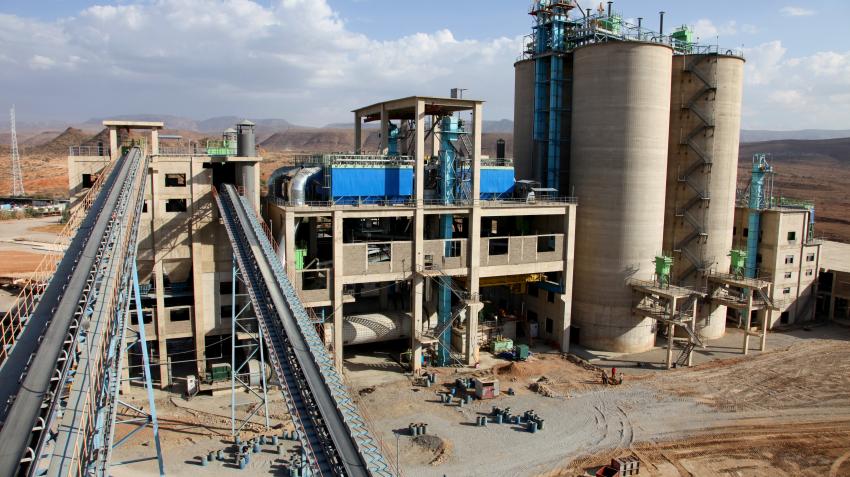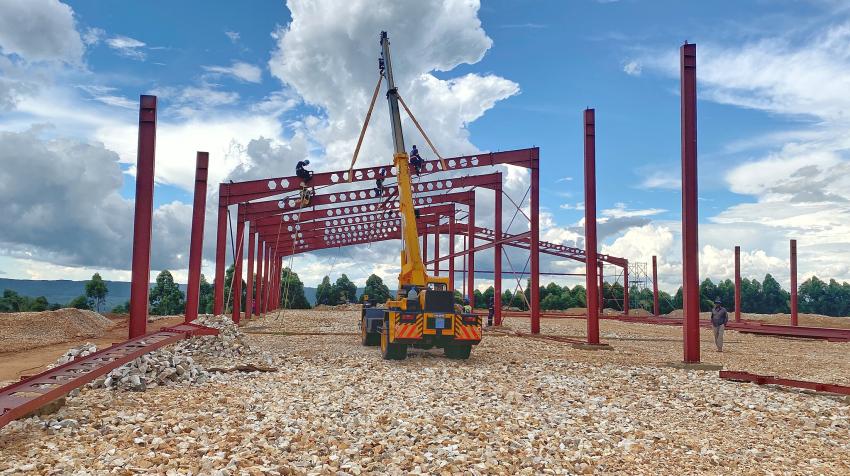17 November 2023
The title of this article was derived from the first sub-theme of the Africa Dialogue Series 2023 of the United Nations Office of the Special Adviser on Africa.
A policy brief co-authored by the United Nations Office of the Special Adviser on Africa in May 2023 highlights statistics indicating that the middle-class population in Africa could increase to more than 40 per cent of the total population on the continent by 2060. This demographic shift provides Africa with an unparalleled opportunity to accelerate its industrialization, paving the way for a Fourth Industrial Revolution.
The evolution of Africa's industrial landscape is a narrative deeply interwoven with the ascendance of its middle class and a strategic shift towards continental import substitution.1 The demands and preferences of this burgeoning middle class play a critical role in shaping the continent's economic trajectory, including Africa taking its rightful place on the global economic stage. How are these dynamics converging to impact Africa's transition to the Industry 4.0 model?
Examining Africa's historical attempt at import substitution strategies
African countries pursued import substitution strategies from the 1940s to the 1950s and from the 1960s to the 1970s. However, these strategies did not bear fruit. In the 1940s and 1950s, colonial governments did not consider industrialization a policy priority, viewing African colonies as mere sources of low-cost raw materials and markets from which to export manufactured products. In the 1960s, the profile that colonial States inherited was not fit to deliver a sustainable industrialization process based on import substitution strategies; thus commodity-dependent States emerged, built on resource extraction.
The 2022 Report of the Secretary-General on the Promotion of Durable Peace and Sustainable Development in Africa further highlights this phenomenon. When African countries achieved independence, they inherited governance structures that were not designed to run effective States built on the vision of a genuinely independent actor with a capable, integrated industrialization policy.
Economically, while colonial administrations focused on resource extraction and tax collection, they did not promote economic development, production and investment. They also prioritized the importance of exercising authority over upholding the rights of individuals in terms of the rule of law. Even with regard to land use, these administrations aimed to control strategic sites for their location or economic value rather than ensuring the presence of the State.
While increasing consumption power is a good start, in the long term, African countries should transform their economies, aiming to produce for domestic and export markets.
For the past five decades, Africa has been unable to escape this colonial-era business model. And the continent’s reliance on commodities tethered its economies to the lowest echelons of global value chains. Because of this commodity-dependence model, many value-added products that are relished in Africa are sourced externally. As the middle class expands, so might the appetite for these value-added imports.
It is therefore crucial to learn these lessons from the continent’s history and unsuccessful attempts to implement import substitution strategies, and adopt an approach that champions and protects the “Made in Africa” ethos. In the twenty-first century, the situation is also entirely different because Africa is displaying higher levels of political will to control its own economic and financial flows.
Africa's middle class: A new engine for growth
The interplay between the burgeoning African middle class, intra-African trade and industrialization can be leveraged to boost Africa’s economic prosperity. On the one hand, the surging demand for value-added consumer goods can bolster intra-African trade flows and amplify productive capacities. This also requires implementing proactive measures to enhance the efficiency and competitiveness of these capacities while mitigating the risk of exacerbating existing imbalances in international trade that have long hamstrung African economies.
Africans are all aware that the continent must pivot towards economic and export diversification to become less commodity-dependent and climb the echelons of global value chains. But Africans also need to understand that continental import substitution strategies could accelerate this endeavour by unlocking the continent’s industrialization, boosting its capacity to rapidly build the necessary industrial culture, create decent jobs, densify and diversify the economic fabric, consolidate the private sector and improve international reserves management towards fostering durable peace and stability.
In line with the “Africa Rising” narrative and to maximize the potential of Africa’s growing middle class—a portion of which remains vulnerable to external shocks, including those living on $2 to $4 per day—the continent needs to build a broad-based producer economy, raising purchasing power and facilitating the demand for efficiencies in both the public and private sectors. While increasing consumption power is a good start, in the long term, African countries should transform their economies, aiming to produce for domestic and export markets.

Ultimately, Africa’s growing middle class provides the continent with one of its most formidable assets: an expanding market.
Continental import substitution: A pan-African vision
Continental import substitution transcends protectionism. It is a clarion call to prioritize African industries and to valorize and mainstream the “Made in Africa” brand. For this vision to bear fruit, it is imperative to consider three fundamental approaches.
First, import substitution cannot lead to inefficient production structures and should be driven by productivity. The African Continental Free Trade Area (AfCFTA) is poised to mitigate this risk. With a potential market of 1.4 billion people, the AfCFTA promises economies of scale and fosters competition, ensuring the availability of superior African products at competitive prices. Policymaking must focus on guarding against inefficiencies, and African nations must learn to build high-productivity, labour-intensive economies capable of leveraging innovation and new technologies. There also needs to be investment towards establishing high-quality capacity-development programmes that provide the continent’s growing labour force with the adequate skills to enter the job market ready to compete at the highest level.
Second, “Made in Africa” must be promoted extensively. A key success factor for this strategy is the elimination of trade barriers for African products. Policymakers must also work together to implement a system that effectively mobilizes the continent’s growing middle class to promote, prioritize and consume “Made in Africa”. Doing so guarantees an investment in Africa’s development and the realization of the common African vision.
Third, opportunities must be leveraged to create a ripple effect. African countries must prioritize a people-centred approach towards enhancing the distributional impact of the AfCFTA, expanding opportunities for the economic participation of women and young people to deliver internally driven sustainable finance. This could further boost the growth of the middle class, strengthening the continent’s productive capacities and accelerating its industrialization—a ripple effect that must be created and sustained to ensure Africa’s competitiveness in the global market.
Africa must honour its global climate commitments. At the same time, the continent’s unique energy requirements must be recognized.
Energy: The cornerstone of industrialization
An Industry 4.0 model requires a reliable energy foundation—the cornerstone of economic transformation, food security, digital education and robust health systems. Yet, Africa is in the throes of an energy paradox: the continent has vast energy resources but suffers from chronic energy shortages. Home to 17 per cent of the world's population, it only accounts for 3.3 per cent of global primary energy consumption. In 2019, the European Union, which has just over a third of Africa's population, consumed three times as much energy, with the combined energy consumption of France and Germany exceeding that of the entire African continent, according to the Mo Ibrahim Foundation.
Without a reliable and affordable energy supply, Africa's industrial dreams are encumbered by higher operational costs and reduced productivity, making competitiveness a Sisyphean task. Addressing this energy chasm is paramount, as a reliable energy matrix is pivotal for sectors such as steel, cement and fertilizer production. The global green energy shift, which hinges on sustainable energy also relies on Africa's potential to process the critical minerals it needs. Africa requires energy investments that go beyond powering homes and turn towards catalysing green jobs and fostering energy-intensive industries.
Global green policies must accommodate Africa's unique context, providing African nations with the opportunity to chart their energy course. A one-size-fits-all approach to energy does not work, including on renewables, and the discourse on energy should prioritize access over transition. So, while African countries endeavour to reach the same “green destination” as the rest of the world, they have every right to map different journeys reflecting their starting points. Africa must honour its global climate commitments. At the same time, the continent’s unique energy requirements must be recognized.
The tapestry of Africa's industrial future is woven by its growing middle class, underpinned by a strategic pivot towards continental import substitution. By embracing these shifts and leveraging the opportunity to chart an energy course corresponding to the situations on the ground, the continent can turn the promises of “Made in Africa” into reality and usher in a prosperous era of Industry 4.0 for its people. This is a path to establishing the Africa we want, the Africa the world needs and the Africa that Africans deserve.
Note
1Not at a national level due to the need for economies of scale.
The UN Chronicle is not an official record. It is privileged to host senior United Nations officials as well as distinguished contributors from outside the United Nations system whose views are not necessarily those of the United Nations. Similarly, the boundaries and names shown, and the designations used, in maps or articles do not necessarily imply endorsement or acceptance by the United Nations.




